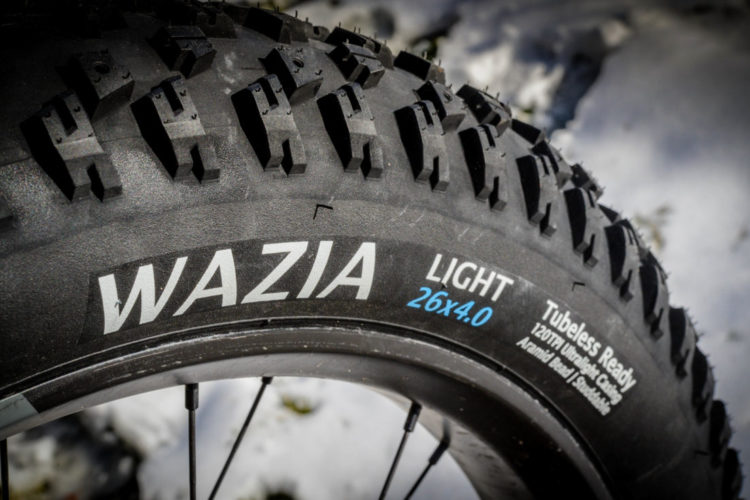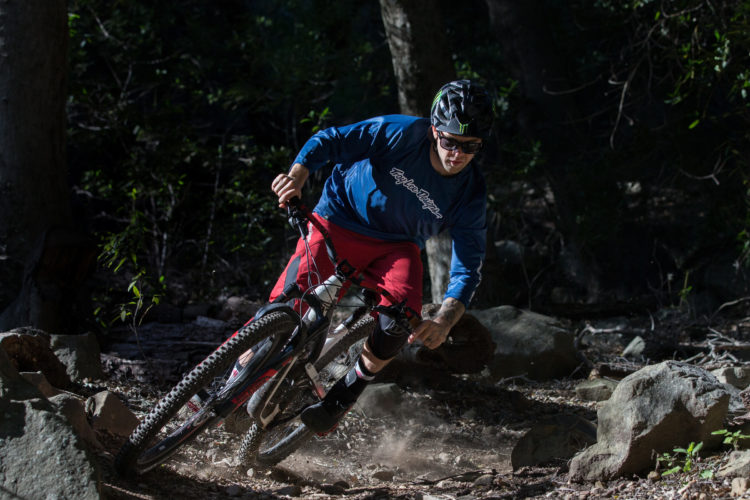
During one of our recent and recurring podcast segments, called Grinding our Gears and Stoking our Spokes, Jeff, Gerow, and I were all equally stoked about one advancement in one piece of MTB tech in particular: tires and tire technology. More specifically, we were hella stoked, brah, about the fact that the three of us had hardly experienced any flat tires this year.
I did have one puncture in particular, using the lighter duty Vee Rail Escape after quite a few miles, on a hard ride down a local and very rocky trail. With a solid puncture, it ended the Rail Escape’s life, and I still had a quarter-mile of rocky trail back to the trailhead. This made for an interesting testing scenario, as I had a set of carbon review wheels on my bike and CushCore Pro installed in the flatted tire. Also, I didn’t really feel like walking my bike out. Call me lazy or call me crazy.
So, I kept it around 5-7MPH and continued rolling. I wasn’t brutishly slamming the wheel into rocks or anything, but rode it harder than I would have if I really cared about the rim. After a few direct rock strikes to the rim on the way out, there was no damage to the carbon wheel, and I can’t help but think that the CushCore Pro had something to do with it.
Earlier this year, CushCore updated its inserts and came out with models for gravel, XC, and plus-tires, rechristening the enduro-models as CushCore Pro. CushCore also made its testing data available to attempt to support their ride feel claims.
Specs

- Pro fits tires 2.1-2.6″ wide, internal rim widths of 22-35mm. Weight: 254g each for 27.5″
- XC fits 1.8-2.4″ wide, internal rim widths of 22-32mm. Weight: 154g each for 29″
- MSRP: $150 for the set, individuals sold for $76 (search current prices, available sizes)
Installation

The said benefits of CushCore don’t come without a price to pay, and the installation is one of them. It’s hard to compete with Aaron’s visual description here when he tested the first rendition of CushCore, so I will compliment his description and did indeed end up as sweaty and frustrated as Stallone.
Yes, CushCore’s installation video with tips from the brand helps, just like giving your cat a little CBD will help you get him in a bath. It might take the edge off, but you’re still going to be wrestling for a little while. The seamless five-minute video would have you think it’s a breeze, but I started to fall behind at a minute-and-a-half in, on step 3. The Pro insert needed to be stretched around the rim, and even this simple task took me a few minutes.
Overall, CushCore Pro inserts took more than an hour per wheel to install. The most helpful elements of the video were getting one side of the tire on completely, with the “roll and tuck” technique, and then “dropping the bead.” The “roll and tuck” means pulling the top of the tire towards you while it’s on the rim, and then pushing it away and pressing the bead into the rim with your thumbs. I’ve never thought of video gaming as being helpful toward any physical endeavor in life, but if there was one instance where I wish I had stronger thumbs, this was it.

By dropping the bead, you give the tire more space to repeat the process on the other side. Following through with this was the most important step in the process of getting the insert installed.
I will say that the process was much easier when I installed the CushCore XC inserts. They are far narrower and easier to work with than the Pro models.
Performance

One of the other costs associated with CushCore is the weight. My 27.5-inch Pro inserts weigh over a half-pound each and it is easy to notice the added weight. The XC inserts are much lighter, and mine weigh 100g less than the Pro version.
I mounted the XC inserts on my bike for BC Bike Race, and one Pro insert on my rear wheel on my Banshee Spitfire. CushCore XC was my insurance for BC Bike Race, and although it was a weight penalty in a race where most riders in a race are looking to shave weight, I didn’t have one issue with either tire during the whole week.
I ran much lower air pressure with both CushCores, dropping about 3-5PSI per tire. The insert acts the same way a volume spacer in a shock or fork would, allowing air pressure to be reduced. So, on the Fezzari Signal Peak I rode, I was close to 18-19PSI in the front and 22-23PSI in the rear. This may sound low, but 18PSI in a tire with CushCore feels as firm as a tire without one that’s inflated to 23PSI or so. These are rough guesstimates, but those were the ranges I needed to drop my tire pressure down to, in order to feel comfortable.

I quickly became aware of the reduced tire squirm with CushCore aboard. The sidewalls feel stiffer around hard cornering and stayed more upright. The T-structure of the inserts drops deep into the rim channel and pushes outward into the sidewalls to keep them in place.
One of CushCore’s biggest claims based on the new data they released is that the inserts dampen vibrations and bumps, making for a much less shaky ride than without them installed. According to CushCore, a 150mm travel bike would feel more like a 173mm travel bike. Or, a bike will need to use 16% less travel than it typically does because the tire absorbs more of the impact at the ground before forces reach the suspension.
I could feel a damping sensation with both CushCore XC and Pro inserts, but it was still pretty hard for me to call it a suspension enhancement product. I don’t doubt that Richie Rude and Loic Bruni can tell a difference in vibration damping or suspension performance with CushCore, but for the majority of us, it’s mostly carbon rim insurance and flat protection.
Who’s it for?

Many of us have figured out if tire inserts are for us or not by now, as they are a few years old at this point. What I like about the new CushCore offerings is that there are less heavy inserts for some of us who want a smaller insurance plan than the full-on enduro Pro model. As a lighter rider, I don’t frequently puncture tires, and have only ever damaged one carbon rim. I don’t need much more protection than a few extra PSI, or a heavier tire casing. I could see myself using one of the XC inserts on occasion though, in the rear tire of an enduro bike. There’s also the dilemma that they need to be re-installed with every new tire, and eventually the inserts themselves need to be replaced. The other bummer is that the inserts cost as much as a new tire itself.
Heavier, more hard-charging riders and racers who are hard on tires and wheels will see the inserts as a godsend, however, allowing them to ride longer, worry less, and pay for fewer tires and rims.
Final word

My first few years of mountain biking were plagued by flat tires and I would have put good money toward flat and rim protection. Since then, tire and tubeless technology has advanced to a splendid point. I don’t think CushCore is for everyone as there are better sealants and better tires these days. For heavier, harder riders, and those who want the summit of rim protection and tire performance, CushCore is an easy choice.
⭐️Find the Cushcore Tire Inserts at REI.com and other retailers.
Thanks to Cushcore for providing these tire inserts for review.



















